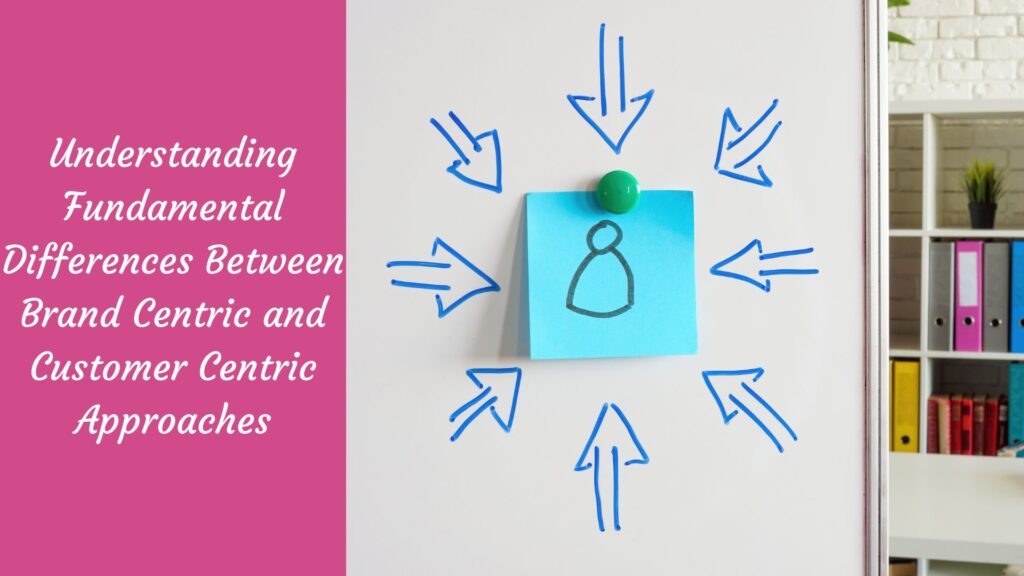In the quest to broaden their horizons and solidify their market presence, companies often embark on two distinct paths: the brand centric and the customer-centric approaches. These strategies, while equally effective, diverge in their core principles and objectives.
Join us as we delve into the captivating world of these two approaches, uncovering their implications for product teams, SaaS specialists, developers, IT enthusiasts, SaaS product users, and customers alike. Get ready to explore!
What is Brand Centric Approach
The brand centric approach prioritizes the company’s image and reputation in the market. The main objective is to establish a distinctive brand identity that not only distinguishes itself from competitors but also profoundly resonates with customers, setting it apart in a crowded marketplace.

The company seeks to establish itself as a leader in the industry rather than just a provider of products or services. The main objective is to cultivate a devoted customer base that resonates with the brand and its principles. This approach places a heavy emphasis on marketing, advertising, and public relations.
Companies invest in creating memorable advertising campaigns, developing slick branding materials, and cultivating relationships with the media. They also prioritize the design and aesthetics of their products or services, ensuring that they align with the brand image.
While a brand centric approach can be practical in building awareness and recognition, it can sometimes come at the expense of customer satisfaction. Companies become so focused on their brand image that they overlook the needs and preferences of their customers. They may also place too much emphasis on marketing and branding rather than product development and improvement.
What is Customer Centric Approach
The customer-centric approach prioritizes the needs and preferences of customers over the company’s brand identity. It aims to provide the best possible experience for customers, from initial interaction to ongoing use of the product or service.

The company seeks to understand the Customer’s journey and pain points and creates solutions that address their specific needs.
The primary goal is to build long-term relationships with customers by delivering a superior customer experience.
This approach places a heavy emphasis on customer service, user experience design, and data analytics. Companies invest in training their customer service teams to be knowledgeable and empathetic, creating intuitive user interfaces, and analyzing customer feedback to identify areas for improvement. They also prioritize regular product updates and enhancements to keep up with customer needs.
While a customer-centric approach can be practical in building solid relationships and loyal customers, it can sometimes come at the expense of brand recognition. Companies become so focused on meeting the needs of individual customers that they overlook the bigger picture of their brand identity. They may also neglect marketing and advertising efforts, which can result in lower customer acquisition rates.
Brand Centric Vs Customer Centric Approach: Which One is the Perfect Strategy for You?
Here is a detailed comparison table on the topic of brand-centric vs customer-centric approach:

| Criteria | Brand-Centric Approach | Customer-Centric Approach |
|---|---|---|
| Focus | The focus is on building a strong brand reputation and positioning. | The focus is on customer success and building long-term relationships. |
| Goal | The goal is to create the best product quality, regardless of the customer experience. | The goal is to create the best customer experience, regardless of the product quality. |
| Advantages | – Shorter time to build a solid brand reputation and position.
– More flexibility within the company. |
– Creating happy customers and keeping them happy is the entire focus for the product team and the company.
– Allows for a loyal fan base, which eventually leads to long-term success. |
| Disadvantages | – More focus on the customers might lead to a decrease in product quality.
– Takes longer to build a loyal fan base. |
– Extensive preparation and thorough market research are necessary, demanding both time and financial investment.
– Business structure is more prone to problems. |
Which strategy should I choose?
The decision between a brand centric or customer-centric approach ultimately depends on the specific goals and values of your company. A brand centric approach may be more suitable for companies looking to establish a strong presence and narrative in the market.

In contrast, a customer-centric approach is ideal for those prioritizing customer satisfaction and loyalty.
It’s important to strike a balance between both strategies, as they are not necessarily mutually exclusive. A strong brand identity can attract customers, but in order to retain them, their needs and preferences must also be met.
Similarly, a customer-centric approach can build loyalty, but without proper marketing and branding efforts, it may struggle to gain visibility in the market.
Understanding your TG and their needs is vital for strategizing in line with your company’s goals. Analyzing data regularly helps inform decisions and develop a well-rounded approach considering brand identity and customer satisfaction. Continuously adapting and evolving is key to staying competitive in the ever-changing business landscape.
Implications for Product Teams, SaaS Teams, Developers, IT-minded Folks, Users of SaaS Products, and Customers of SaaS Products
Product teams, SaaS teams, developers, IT-minded folks, users of SaaS products, and customers of SaaS products all have a stake in the Brand-Centric vs Customer-Centric debate.
Each group has unique priorities and needs and must decide which approach aligns best with their goals.

Product teams and SaaS teams, for example, may prefer a customer-centric approach, as it allows them to gather feedback and improve their products based on customer needs. Many developers prefer a brand-centric approach as it enables them to effectively demonstrate their skills and expertise.
IT-minded folks may benefit from a customer-centric approach, as it can make their jobs easier by providing intuitive interfaces and streamlined processes.
Users of SaaS products and customers of SaaS products will likely appreciate a customer-centric approach, as it emphasizes their needs and preferences.
However, they may also value a strong brand identity, as it can indicate professionalism and reliability. The best approach depends on the specific product or service, the target audience, and the company’s goals and values.
FAQs

What are the key differences between a brand-centric and a customer-centric approach?
- Focus: A brand-centric approach emphasizes the brand’s vision, culture, and values, while a customer-centric approach prioritizes the needs, preferences, and experiences of the customers.
- Feedback and Adaptation: In a brand-centric approach, feedback and change are often driven by internal stakeholders. In a customer-centric approach, customer feedback is crucial and drives adaptation and improvements.
- Product Development: With a brand-centric model, products or services are developed based on the brand’s vision and objectives. Conversely, in a customer-centric model, product development is guided by customer needs and expectations.
- Marketing: Brand-centric marketing is geared towards enhancing the brand’s image and reputation. In contrast, customer-centric marketing is personalized and targeted to address specific customer needs.
- Customer Interaction: A brand-centric approach might be more transactional, focusing on selling products or services. A customer-centric approach, on the other hand, focuses on building long-term relationships with customers.
How does a customer-centric approach benefit businesses?
Adopting a customer-centric approach yields numerous benefits for businesses. First, it helps in fostering customer loyalty and retention. When customers feel valued, and their needs are prioritized, they are more likely to continue doing business with the company, leading to repeat sales.
A customer-centric approach helps businesses better understand their customers’ needs, driving innovation and product development. By listening to customer feedback, companies can refine their products or services to match better what the Customer wants and expects.
Third, this approach can lead to positive word-of-mouth and enhanced brand reputation. Delighted customers are prone to enthusiastically recommending the company to their peers, thereby expanding the customer base.
Lastly, a customer-centric approach provides opportunities for businesses to differentiate themselves from competitors. In an increasingly crowded marketplace, offering a superior, personalized customer experience can be a unique selling point that sets a company apart. In sum, a customer-centric approach can drive customer satisfaction, loyalty, innovation, and business growth.
What are the elements of a customer-centric approach?
- Understanding Customer Needs: Businesses need to thoroughly understand their customers’ needs, preferences, and pain points. This understanding can be obtained through customer feedback and data analysis.
- Personalization: A customer-centric approach involves tailoring products, services, and interactions to meet individual needs and preferences, enhancing the customer experience.
- Empathy: It is the ability to understand & share the feelings of another. In a customer-centric approach, businesses need to empathize with their customers’ situations and respond accordingly.
- Consistent Customer Experience: A holistic customer experience across all touchpoints – online, over the phone, or in-person – is crucial. The experience should be consistent, seamless, and of high quality.
- Quick and Effective Problem Resolution: Companies need to address customer issues promptly and effectively. It not only solves the immediate problem but also builds trust with the Customer.
- Long-term Relationship Building: A customer-centric approach focuses on building long-term relationships with customers, not just on single transactions. It involves ongoing engagement and nurturing of the customer relationship.
- Customer Feedback: Actively seeking, listening to, and acting upon customer feedback is an essential element of a customer-centric approach. It can help businesses improve their offerings and customer experience.
How do you assess the success of a customer-centric approach?
- Customer Satisfaction Surveys: Regularly conducting customer satisfaction surveys can help measure the success of a customer-centric approach. These surveys can provide valuable insights into how customers perceive your products, services, and overall experience.
- Net Promoter Score (NPS): The Net Promoter Score (NPS) is a widely recognized and effective tool for evaluating customer loyalty. It quantifies the probability of customers recommending your business, thereby reflecting their satisfaction and loyalty.
- Customer Retention Rates: Keeping track of customer retention rates can be a significant indicator of a successful customer-centric approach. High retention rates suggest that customers are satisfied with your business and choose to remain with your brand.
- Customer Churn Rate: Conversely, monitoring customer churn rates – the number of customers who stop doing business with a company during a given period – can highlight areas for improvement in your customer-centric strategy.
- Customer Lifetime Value (CLV): CLV measures the total revenue a business can reasonably expect from a single customer account. A high CLV indicates a successful customer-centric approach as it reflects customer loyalty and repeat business.
- Social Media Mentions and Reviews: Positive social media and review ratings can signal a customer-centric approach. Customers use these platforms to openly share feedback on businesses.
- Feedback Implementation: Lastly, track how often customer feedback is incorporated into your business strategies and operations. It is a clear sign of a genuinely customer-centric approach and will likely contribute to increased customer satisfaction and loyalty.
What are the risks and rewards of a customer-centric strategy?
Adopting a customer-centric strategy can present both risks and rewards for businesses. On the reward side, a customer-centric approach can significantly enhance customer loyalty and satisfaction. Happy customers are more likely to return for repeat business, recommend your company to others, and provide positive reviews and feedback.
These outcomes can lead to improved sales performance, increased market share, and, ultimately, a more robust bottom line.
However, this strategy also carries potential risks. The most prominent is the potential for misjudgment when it comes to understanding what customers really want or need. If assumptions about customer desires are incorrect, businesses may invest heavily in strategies or products that fail to resonate, resulting in wasted resources and potential damage to brand reputation.
Secondly, a focus on customer satisfaction could potentially lead to overlooking other crucial business aspects such as cost control, operational efficiency, and employee satisfaction.
Lastly, businesses must also be wary of over-reliance on a single customer or a small group of customers, which can put them at risk if those customers’ preferences change or they decide to take their business elsewhere.
While a customer-centric approach can significantly enhance business performance, it must be executed carefully, with a balanced perspective that considers all facets of the business.
What are the best practices for implementing a customer-centric approach?
To effectively implement a customer-centric strategy, there are several best practices to consider:
- Understand Your Customers: Start by building detailed customer personas to know who your customers are, their needs, preferences, and pain points. Conduct surveys, interviews, and focus groups, and use data analytics to get a comprehensive understanding.
- Personalize Your Interactions: Tailoring your interactions based on individual customer needs and preferences can significantly enhance customer satisfaction. Use customer data to provide personalized products, services, or content.
- Prioritize Customer Feedback: Regularly solicit feedback from your customers and listen to what they have to say. Feedback provides valuable insights for improving your products or services.
- Ensure Excellent Customer Service: Strive to provide exceptional customer service at every touchpoint. Timely, responsive, and helpful customer service can significantly enhance customer loyalty.
- Align Your Organization: A customer-centric approach requires an organizational culture that prioritizes customer satisfaction. Ensure that every department, from sales and marketing to product development and customer support, has this focus in mind.
- Measure Success: Establish key performance indicators to gauge success in prioritizing customer satisfaction. These may include metrics such as satisfaction scores, net promoter scores, and retention rates. Consistently review these indicators to identify opportunities for enhancement and growth.
By following these practices, businesses can effectively implement a customer-centric approach, enhancing customer satisfaction and loyalty while mitigating potential risks.
How do you measure customer engagement with a customer-centric approach?
- Use Engagement Metrics: Start by measuring customer engagement through key metrics like time spent on your website, number of pages viewed, and frequency of visits. These metrics can provide insights into customer behavior and engagement levels.
- Monitor Social Media Interactions: Social media platforms are a treasure trove of customer engagement data. Keep track of likes, shares, comments, and mentions to gauge how engaged your customers are with your brand.
- Track Email Open and Click-Through Rates: Pay attention to your email marketing campaigns. High open and click-through rates usually indicate a higher level of customer engagement.
- Survey Customer Satisfaction: Regularly survey your customers to measure their satisfaction levels. It can be done through net promoter score surveys or customer satisfaction surveys.
- Analyze Customer Feedback: Lastly, always take the time to analyze and understand your customer feedback. Whether it’s reviews, complaints, or suggestions, this feedback provides valuable insights into how engaged and satisfied your customers are with your brand.
How can businesses use customer feedback to improve their customer-centric strategies?
- Identify trends and patterns: Analyze customer feedback to identify common trends and recurring issues. These insights can help businesses understand what’s working and what’s not in their customer service approach.
- Address customer complaints: Use negative feedback as an opportunity to improve. Addressing customer complaints promptly and effectively can boost customer satisfaction and loyalty.
- Improve products or services: Feedback often includes suggestions for product or service enhancements. Businesses can use this to make necessary modifications and improvements.
- Personalize the customer experience: Businesses can use feedback to understand individual customer preferences and needs, allowing them to tailor their offerings to provide a personalized customer experience.
- Measure the impact of changes: After implementing changes based on customer feedback, businesses should measure the impact of those changes on customer satisfaction and engagement to assess the effectiveness of their customer-centric strategies.
Conclusion
The ongoing Brand-Centric vs Customer-Centric debate presents both exciting opportunities and unique challenges. Companies face the vital task of aligning their goals and values with the needs and preferences of their stakeholders.
Product teams, SaaS enthusiasts, developers, IT-minded individuals, SaaS product users, and customers all contribute to determining the optimal approach. By grasping the fundamental differences between these two approaches, companies can make informed decisions that pave the way for long-term success.
Get ready to embark on an exhilarating journey of discovery and growth!

10+ years experience in Marketing and Operations
